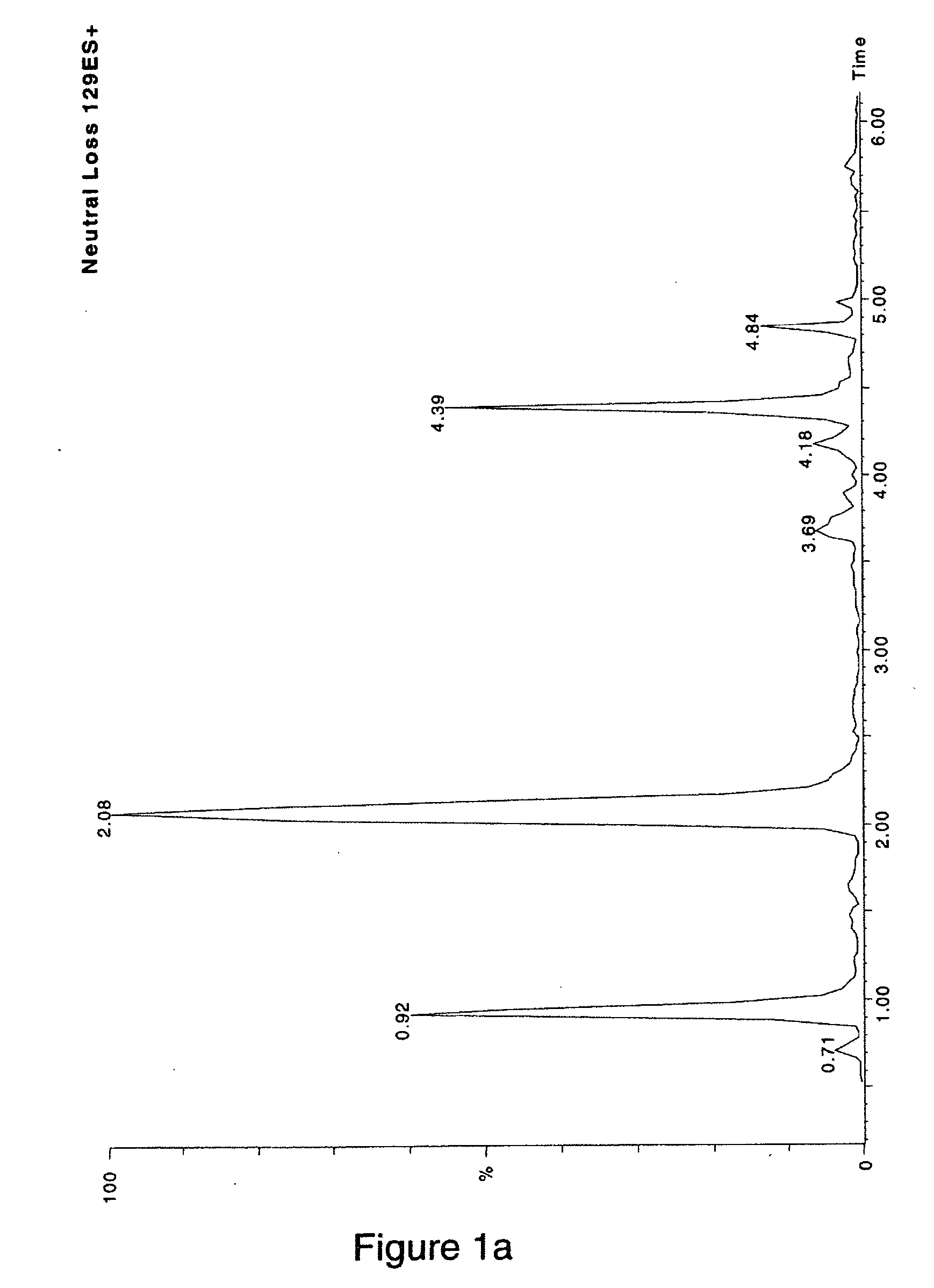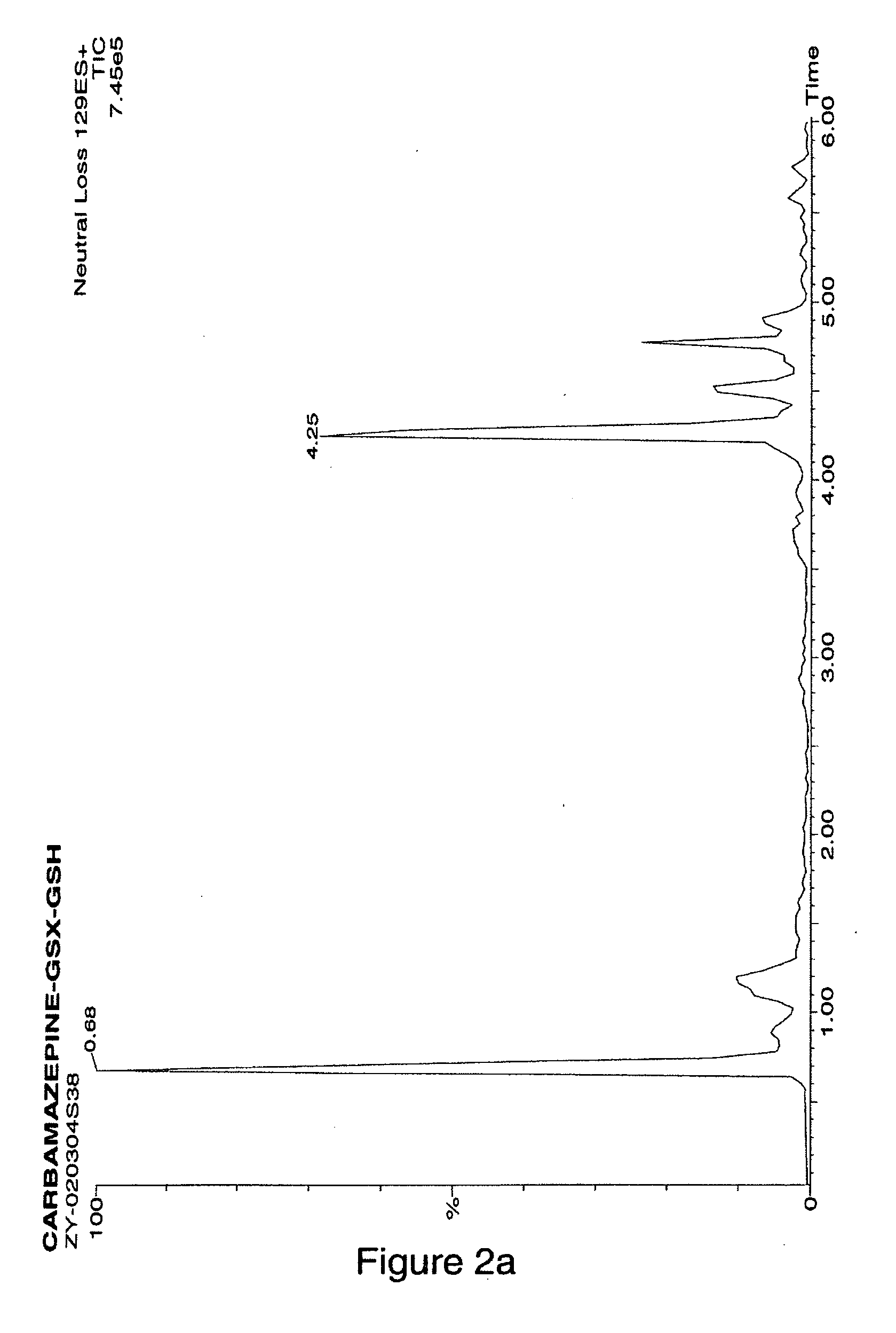Method for detecting reactive metabolites using stable-isotope trapping and mass spectroscopy
a technology of reactive metabolites and mass spectroscopy, which is applied in the direction of instruments, assay labels, material analysis using wave/particle radiation, etc., can solve the problems of high development cost for the pharmaceutical industry, morbidity and mortality of patients, and no animal model that can be used to evaluate such reactions
- Summary
- Abstract
- Description
- Claims
- Application Information
AI Technical Summary
Benefits of technology
Problems solved by technology
Method used
Image
Examples
example 1
Standard Procedures
A. Incubation & Stable Isotope Trapping:
[0088] All microsomal incubations described herein were performed at 37° C. in a water bath. The test compound (or drug candidate) was mixed with human microsomal proteins in 50 mM potassium phosphate buffer (pH 7.4) supplemented with GSH and GSX that were pre-mixed at an equal molar ratio of 1:1. Reaction mixtures were then warmed at 37° C. for 5 min. The reactions were initiated by the addition of a NADPH generating system to yield a final volume of 1000 μL. The final reaction mixtures contained 10 μM test compounds, 1 mg / mL microsomal proteins, 1 mM GSH and GSX, 1.3 mM NADP+, 3.3 mM glucose-6-phosphate, 0.4 U / ml glucose-6-phosphate dehydrogenase, 3.3 mM magnesium chloride. After a 60 min incubation, the reactions were terminated by the addition of 150 μL of trichloroacetic acid (10%). The samples were centrifuged at 10,000 g for 15 min at 4° C. to pellet the precipitated protein, and the supernatants were subjected to ...
example 2
[0092] Acetaminophen's metabolites are well characterized in the art. More particularly, acetaminophen is known to form the reactive metabolite N-acetyl-p-benzoquinone imine (NAPQI) via oxidation reactions mediated by CYPs as shown in Scheme 1.
[0093] In the in-vitro incubation, NAPQI, the known reactive metabolite, was trapped to form two isotopic glutathione adducts (NAPQI-SG, 456 Da; NAPQI-SGx, 459 Da).
[0094]FIG. 1A shows the total ion chromatogram (MS) of the neutral loss scanning of 129 Da obtained for the reaction mixture. Three major components were detected in the MS designated as A (2.08 min), B (0.92 min) and C (4.39 min), based on the peak intensity. The MS spectra for the three components were evaluated as is shown in FIG. 1B. Component A showed a doublet of equal intensities at m / z 457 and 460 Da, respectively (FIG. 1B, top). This MS doublet signature indicated the formation of an adduct of the reactive metabolite NAPQI. In contrast, the spectra of compo...
example 3
[0095] Carbamazepine was selected to demonstrate the applicability of the method of the invention to the detection of reactive arene oxide metabolites. The reaction of carbamzepine with glutathione is outlined in Scheme 2.
[0096]FIG. 2A shows the total ion chromatogram (MS) of the neutral loss scanning of 129 Da obtained for the reaction mixture. Several components showed positive response to the neutral scan, but only one component at a retention time of 4.5 min displayed the characteristic doublet at m / z 560 and 563 Da (FIG. 2B).
PUM
| Property | Measurement | Unit |
|---|---|---|
| mass | aaaaa | aaaaa |
| pH | aaaaa | aaaaa |
| volume | aaaaa | aaaaa |
Abstract
Description
Claims
Application Information
 Login to View More
Login to View More - R&D
- Intellectual Property
- Life Sciences
- Materials
- Tech Scout
- Unparalleled Data Quality
- Higher Quality Content
- 60% Fewer Hallucinations
Browse by: Latest US Patents, China's latest patents, Technical Efficacy Thesaurus, Application Domain, Technology Topic, Popular Technical Reports.
© 2025 PatSnap. All rights reserved.Legal|Privacy policy|Modern Slavery Act Transparency Statement|Sitemap|About US| Contact US: help@patsnap.com



